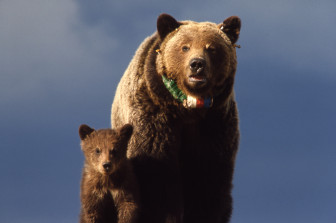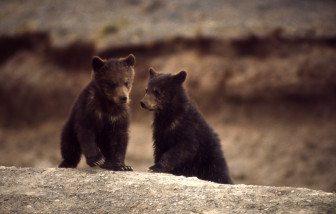By Derek Goldman, Northern Rocky Mountain Representative for the Endangered Species Coalition
This past December marked the 40th anniversary of near-unanimous passage by Congress of the Endangered Species Act of 1973 – one of our nation’s most important wildlife conservation laws. Thanks to Act, Americans have the opportunity today to hear the calls of the bald eagle and peregrine falcon, catch a glimpse of an alligator in the wild, and hear the howl of the gray wolf throughout the northern Rockies region.
The Endangered Species Act carries a special significance here in the northern Rocky Mountains – home of the last of Lower 48’s largest species of bear: the grizzly. Although often thought of as carnivores, grizzly bears are actually omnivores. They subsist on a wide variety of forest foods, including grasses, nuts, berries, insects, small mammals, fish, ungulates and carrion. Estimated at around 50,000 bears in the western U.S. in the early 1800s, the great bear was persecuted as settlers moved in. By the time grizzlies were protected in 1975, there may have been as few as 150 bears in and around Yellowstone National Park. Today, biologists estimate that between 600 and 740 bears inhabit the Yellowstone region, plus almost 1,000 bears along the Northern Continental Divide—an ecosystem in North-Central Montana contiguous with Canada. Indeed, thanks to the Endangered Species Act, the grizzly bears have been slowly recovering from the brink of extinction in these two “recovery areas.”

This rebound in the bear population is the result of concerted and laudable efforts by federal, state and tribal wildlife agencies, conservation groups, sportsmen, and landowners, who have worked to protect bear habitat and reduce human-grizzly bear conflict—the leading cause of bear mortality. These efforts have involved raising public awareness about how to live, work and recreate safely in bear country, while implementing important regulations designed to keep grizzly bears alive and provide secure habitat. The grizzly bear’s return from historic low numbers is a testament to the importance and effectiveness of the Endangered Species Act.
Not that the grizzly bear doesn’t face challenges. Indeed, it does. In the Yellowstone region, several important bear foods have been in decline for years, notably whitebark pine trees, whose nuts provide important nutrition as bears are fattening up for winter hibernation. And conflicts between bears and humans have been on the rise in recent years. Furthermore, the Yellowstone population of grizzly bears remains isolated and has yet to make a natural connection to the more robust populations of bears to the north.
Scientists on the Interagency Grizzly Bear Study Team suggest that, so far, these opportunistic omnivores are adapting to the changing food resources within their ecosystem. A series of papers presented at the December meeting of the Interagency Grizzly Bear Committee (IGBC) seem to indicate that bears are surviving, producing cubs, and continuing to expand their range into places they haven’t been seen in a long time. Other scientists are concerned, because these same studies indicate that there has been a drop in cub survival, a slight decrease in body fat in females, and an increase in human-caused mortalities in some parts of the ecosystem.

At the December meeting, the IGBC recommended the Yellowstone grizzly bear be removed from the list of threatened and endangered species. In the coming year, we expect that the U.S. Fish and Wildlife Service will propose to do just that.
Working with our member groups and allies in the region, the Endangered Species Coalition has been following these developments closely. In 2013, we carefully reviewed and commented on several draft plans that will guide future management of grizzly bears in the northern Rockies to ensure that states will be continue grizzly bear conservation efforts when and if the populations are delisted.
Rest assured, the Endangered Species Coalition will carefully review any delisting proposal – as well as grizzly bear population trends – to ensure that removal of federal protections will not jeopardize this magnificent animal and remarkable Endangered Species Act success story


0 comments on “Yellowstone Grizzly Bears – An Update from the Field”